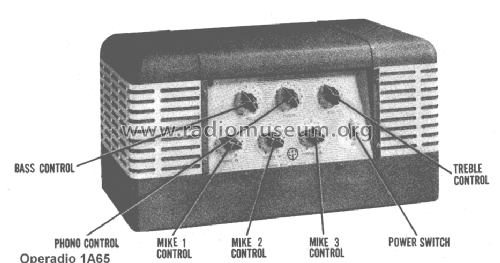ampmadscientist
Well-Known Member
I was surprised to learn that Operadio goes back to 1922!
But the amp I had was circa 1947.
They used to make outrageous PA speakers, and giant tube PA heads....
Besides making the "first" portable radio receivers.
Audio Pre-Amplifier 1A65 Ampl/Mixer Operadio Corp.; St.

 Vintage Operadio Model WH7003 Speaker
Vintage Operadio Model WH7003 Speaker
Audio Pre-Amplifier 1A65 Ampl/Mixer Operadio Corp.; St.Audio Pre-Amplifier 1A65 Ampl/Mixer Operadio Corp.; St. Charles IL, build 1948 ?, 1 pictures, 4 schematics, 6 tubes, United States of America , semiconductors
View on www.radiomuseum.org
These guys were the true pioneers of pro sound. The amps they built ate mesa boogies for breakfast.
(these amps grind like a chain saw on steroids)
Infinite sustain, the volume goes to 20.
(That's 10 more, isn't it?)
But the amp I had was circa 1947.
They used to make outrageous PA speakers, and giant tube PA heads....
Besides making the "first" portable radio receivers.
Audio Pre-Amplifier 1A65 Ampl/Mixer Operadio Corp.; St.

 Vintage Operadio Model WH7003 Speaker
Vintage Operadio Model WH7003 SpeakerAudio Pre-Amplifier 1A65 Ampl/Mixer Operadio Corp.; St.Audio Pre-Amplifier 1A65 Ampl/Mixer Operadio Corp.; St. Charles IL, build 1948 ?, 1 pictures, 4 schematics, 6 tubes, United States of America , semiconductors
View on www.radiomuseum.org
Preview by Yahoo
These guys were the true pioneers of pro sound. The amps they built ate mesa boogies for breakfast.
(these amps grind like a chain saw on steroids)
Infinite sustain, the volume goes to 20.
(That's 10 more, isn't it?)
Attachments
Last edited:
















